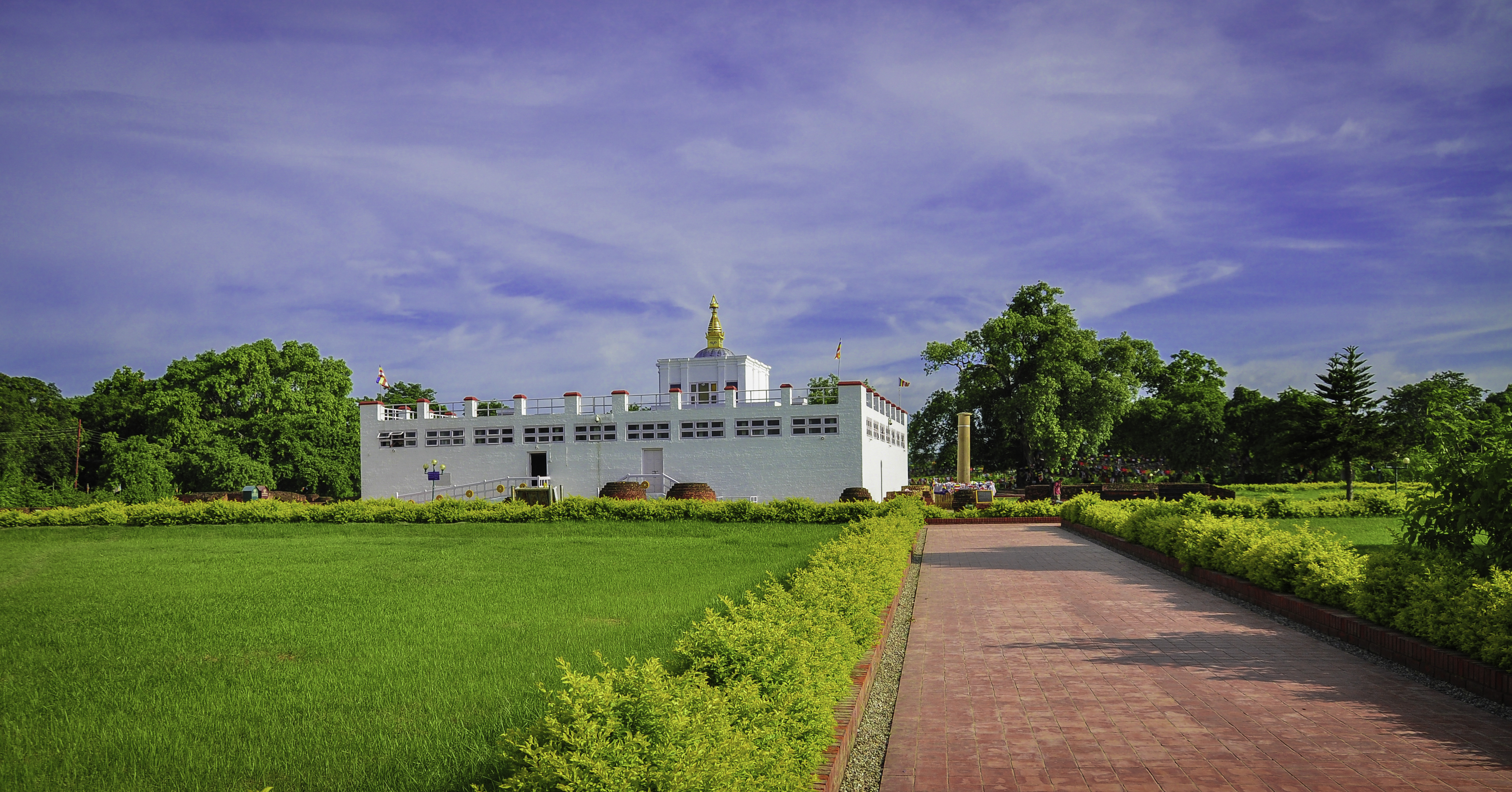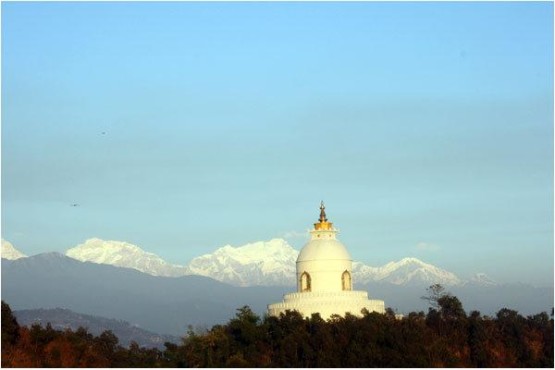- HOME
- Destination
- Adventure Activities
- About Us
- BLOGS
- CONTACT US

Lumbini (meaning ‘the lovely’ in Sanskrit) is one of the world’s most spiritual sites and is the birthplace of Gautam Buddha, often known as ‘the light of Asia.’ Gautam Buddha is the founder of Buddhism. Lumbini lies in the Rupendehi district of Province number 5 of Nepal. Lumbini is located 25 kilometers east of the municipality of Kapilvastu. It is 4.8 km in length and 1.6 km in width.
The whole Lumbini is divided into the large monastic zones, separated by the long water-filled canal. Nothing can be built here except monasteries. The eastern monastic zone has the Theravadin monasteries and the western monastic zone has the Mahayana and Vajrayana monasteries. There are also motor boats which provide tours for the visitors.
There are many temples, and monasteries build within the Lumbini area by the various Buddhist countries around the world. There are more than about 25 international Buddhist monasteries. The site along with the monasteries has a Bodhi tree, the Ashoka pillar, an ancient bathing pond, and the Mayadevi Temple, which is believed to be the exact birthplace of Gautam Buddha. Because of its cultural, religious and historical importance, UNESCO listed Lumbini in the list of World Heritage Sites in 1997.
Lumbini has access to both the airways and roadways. So, the choice is up to the visitor which he/she would prefer.
Flights are available every day from Kathmandu to reach Bhairahawa. It is about a 45 minutes flight from Kathmandu to Bhairahawa. After landing on the Bhairahawa airport, catch a bus, taxi or a rickshaw to reach to Lumbini. It is only 30 minutes far. There is also a direct flight from Pokhara to Lumbini in a day by Buddha Air. You can choose to go to Lumbini from Pokhara as well.
The travel is a cheaper and more common means to reach Lumbini. From Kathmandu, Pokhara or Chitwan, you can get a bus to Bhairahawa. It is about 6-9 hours travel from Kathmandu and Pokhara whereas it will take you about 5-6 hours to reach Bhairahawa from Chitwan. From Bhairahawa, you can now catch a local bus, taxi or a rickshaw.
Lumbini experiences a subtropical monsoon climate. May and June are the hottest months with frequent rain from June to August. The winter (December to February) is a warm climate with an average temperature of 20°C which can sometimes fall to 8-10°C. October to November is the favorable time to visit Lumbini for the weather is very good during these times of the year. However, April and May is also a good time to visit Lumbini, since the Buddha Jayanti, the major festival of the Buddhist fall during these months and is celebrated grandly.
The Maya Devi Temple is the most visited and major attraction of Lumbini. The white color temple protects the exact birthplace of the Gautam Buddha. The Bodhi tree nearby is where Mayadevi rested while in her labor. The Maya Devi Temple records the story of Maya Devi, the mother of Gautam Buddha. She gave birth to Siddhartha Gautam under a banyan tree, and the temple stands in the site of the tree. The pond next to the temple is where Maya Devi took a dip before giving birth to Siddhartha Gautam. It is also believed that the pond is the first place where Siddhartha Gautam took his first bath after birth.
The lovely white World Peace Pagoda is located outside the main compound but is easily accessible by the bikes. It is one of the world’s greatest stupas. The stupa was constructed by Japanese Buddhists at the cost of one million US dollars. The stupa illustrates the golden statue of the Gautam Buddha in a posture that is believed to be when Buddha was born. In the periphery of the stupa, there is a grave of a Japanese monk who is murdered by an anti-Buddhist during the construction of the stupa.

World Peace Pagoda
The Royal Thai Buddhist Monastery is located at the north end of the pond. The huge architecture is made up of white marbles. The beautifully standing monastery against the blue sky makes anyone stare at it for a while. The meditation center with a blue roof is another masterpiece of art.
Zong Hua Buddhist Monastery is a beautiful and one of the most impressive structures in Lumbini. The monastery is built on pagoda style and gives a feeling of a small peaceful city.
Emperor Ashoka built the Ashoka pillar in 249 BC, during his visit the village in Lumbini. It is 12.97 meters high. He built four stupas, the pillar and an inscription that describes his visit and the importance of the Lumbini as a birthplace of Gautam Buddha. The pillar is surrounded by a small fence, decorated by colorful flags and has bowled to light the Incense stick by the prayers.

Ashoka Pillar
Myanmar Golden Temple is among the oldest structure in Lumbini. The temple contains three prayer halls inside it. It also has the Lukmani Pula Pagoda temple and another Burmese style pagoda which is similar to the Shwedagon pagoda in Yangon.
The Lumbini museum lies at the northern end of the Lumbini area. The museum contains the photographs and the artifacts from the Buddhist sites not only from Lumbini or Nepal but also from the sites all over the world.
The government of South Korea built the Korean Buddhist Temple. It is a huge temple with a magnificent interior. The beautifully intricate ceiling with amazing colors will take you to an entirely different world.
The Puksarni Pond is near the south of the Ashoka pillar. In this pond, Mayadevi; the mother of Gautam Buddha took a bath before giving birth to him. The prince Siddhartha Gautam also had his first purification bath in this pond. The pilgrims take a holy dip into the pond in present days. There are ruined foundations of brick pagodas around the pond which bring us back to the 2nd century BC and 9th century AD.
The Great Lotus Stupa was constructed by the German Tara Foundation. The stupa is important not only because of its marvelous structure but also because of the religious norms it associates within itself. The measurements for the construction of the stupa were made according to the rules back to thousands of years, during the time of Gautam Buddha. There is a meditation hall at the center of the stupa with a diameter of 20 meters.
The beautiful Dharma Swami Maharaja Buddha Vihar is situated outside the main premises of Lumbini area. It is constructed in Tibetan style. 60 monks, who live there, perform Tara Puja in the Vihar every day. The walls of the Dharma Swami Maharaja Vihar have been painted artistically which reflects the Buddhist art.
With so much of the attractions accumulated in an area, Lumbini is a very preferred place to visit by the national as well as foreign tourists. Every year many Buddhists and Hindus all around the visit the place to explore the Buddhism and the culture. If you are planning to visit any spiritual place in South East Asia, Lumbini is a place you should not miss.
Your email address will not be published.Required fields are marked *
You must be logged in to post a comment.
0 Comments on "Lumbini, Nepal: A closer look on Buddha’s Birthplace"